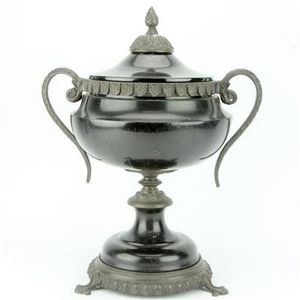Chinese Rock Crystal Censer with Dragon Finial
You must be a subscriber, and be logged in to view price and dealer details.
Subscribe Now to view actual auction price for this item
When you subscribe, you have the option of setting the currency in which to display prices to $Au, $US, $NZ or Stg.
- Finial - An architectural decoration, found on the upper parts of of an object. On furniture they are usually found on pediments, canopies and shelf supports. On smaller ceramic or silver items, such as spoons, they may decorate the top of the item itself, or the lid or cover where they provide a useful handle for removal.
Finials have a variety of shapes and forms. They may be urn-shaped, baluster shaped round or spiral, but usually taper into an upper point. Many real life shapes may also be used as finials, such as pineapples, berries, pinecones, buds, lotus and acorns. Sometimes animals such as a lion are depicted, or fish and dolphins. - Lion Mask - The lion mask has been used for centuries in various forms of art and design, including furniture, silver, and ceramics, and is usually y depicted as a stylized representation of the face of a lion, often with an open mouth and protruding tongue. and is often used as a handle, knob, or other decorative element.
In furniture design, lion masks were popular in the neoclassical and Empire styles of the late 18th and early 19th centuries. They were often used as decorative elements on the legs or arms of chairs, as well as on cabinet and drawer pulls. It was also used as a handle, knob, or other decorative element.
In silverware design, lion masks were often applied to tea and coffee pots, as well as on candlesticks, snuff boxes, and other small silver items. The lion mask was often used in combination with other neoclassical motifs, such as laurel wreaths or acanthus leaves, to create a sense of grandeur and classical elegance.
In ceramics, lion masks were often depicted in relief, and were sometimes used in combination with other decorative elements, such as garlands or swags.
This item has been included into following indexes:
Visually similar items

A George III sterling silver tea urn with carved ivory loop handles and engraved contemporary coat of arms by Benjamin Smith II & James Smith III, London 1810, the original coiled snake finial by Paul Storr. 36 cm high, 4820 grams. The arms are those of Ba

Continental marble lidded urn having cast metal fittings & standing on three feet.

Mantle vase, Royal Worcester, highland cattle, signed John Stinton, model 1958, (a/f: to the lid, on top)

A Chinese silver dragon handled goblet, early 19th century, marked Sun Shinh, Canton. Stamped SS to base, approximately 30 cm high, 26 cm diameter. 871 gms silver
